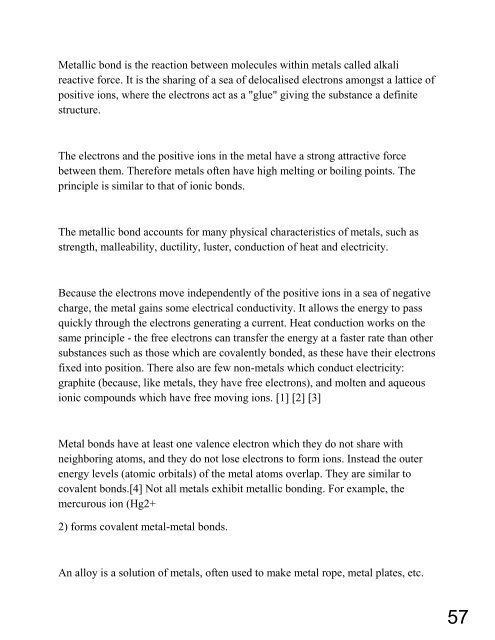Create successful ePaper yourself
Turn your PDF publications into a flip-book with our unique Google optimized e-Paper software.
Metallic bond is the reaction between molecules within metals called alkali<br />
reactive force. It is the sharing of a sea of delocalised electrons amongst a lattice of<br />
positive ions, where the electrons act as a "glue" giving the substance a definite<br />
structure.<br />
The electrons and the positive ions in the metal have a strong attractive force<br />
between them. Therefore metals often have high melting or boiling points. The<br />
principle is similar to that of ionic bonds.<br />
The metallic bond accounts for many physical characteristics of metals, such as<br />
strength, malleability, ductility, luster, conduction of heat and electricity.<br />
Because the electrons move independently of the positive ions in a sea of negative<br />
charge, the metal gains some electrical conductivity. It allows the energy to pass<br />
quickly through the electrons generating a current. Heat conduction works on the<br />
same principle - the free electrons can transfer the energy at a faster rate than other<br />
substances such as those which are covalently bonded, as these have their electrons<br />
fixed into position. There also are few non-metals which conduct electricity:<br />
graphite (because, like metals, they have free electrons), and molten and aqueous<br />
ionic compounds which have free moving ions. [1] [2] [3]<br />
Metal bonds have at least one valence electron which they do not share with<br />
neighboring atoms, and they do not lose electrons to form ions. Instead the outer<br />
energy levels (atomic orbitals) of the metal atoms overlap. They are similar to<br />
covalent bonds.[4] Not all metals exhibit metallic bonding. For example, the<br />
mercurous ion (Hg2+<br />
2) forms covalent metal-metal bonds.<br />
An alloy is a solution of metals, often used to make metal rope, metal plates, etc.


